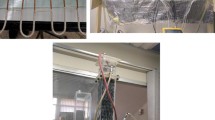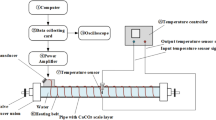Abstract
In order to ensure the safety of deep-sea submarine pipelines, this paper focuses on the analysis of the axial temperature distribution model of the submarine pipeline and the distribution parameter circuit model of the tube bundle heating system. Combined with these two models, theoretical analysis shows that the heating effect of the tube bundle heating system depends on the distributed circuit parameters and power frequency of the system. In order to improve the heat tracing efficiency, the power frequency needs to be adjusted according to the change of the load temperature, so the power supply frequency of the tube bundle heating system based on the Hammerstein model is optimized. Using a neuro-fuzzy algorithm, not only the theoretical values of heating power and power frequency are obtained, but also the drawbacks of determining the above parameters based on engineering experiments are avoided. Moreover, the pipeline heating is efficient and stable, the dynamic response is fast, and the working condition is also well adapted.









Similar content being viewed by others
References
Wang D (2016) Comparison and analysis of active heating technology in deep-water subsea flowline. Petro-Chem Equip 45:64–68
Gooris F, Ansart B, Rageot O, Kaye D, Olivier R et al (2016) Electrically trace heated pipe in pipe: Technology upgrade for extended application range In: Offshore Technology Conference, Houston, USA.
Denniel S (2004) Review of flow assurance solutions for deep water fields. In: Offshore Technology Conference, Houston, USA.
Guo XC, Wu ZY, Shi ZF (2011) Research and application of skin-effect Current Tracing in Submarine Pipeline. In: The 15th China ocean (shore) Proceedings of Symposium, China.
Li PC, Zhou XH, Wang DL et al (2018) Design discussion on the flow assurance for transportation pipelines of high pour point crude Oil. Oil-Gas Field Surf Eng 37(2):52–55
Trichtchenko L (2004) Modeling electromagnetic induction in pipelines. NACE International, New Orleans
Lervik JK, Børnes AH, Nysveen A, Høyer-Hansen M (2007) Electromagnetic modelling of steel pipelines for DEH applications. International Society of Offshore and Polar Engineers, Lisbon
Ahlen CH, Torkildsen B, Klevjer G, Lauvdal T, Lervik JK, Ronningen K (1992) Electrical Induction heating system of subsea pipelines. International Society of Offshore and Polar Engineers, San Francisco
Sun MS, Fang XH, Zheng NF et al (2003) Research on electric heating special frequency converter for heavy oil exploitation. J Univ Pet 27(5):116–118
Fang XH, Sun MS, Xu WH et al (2003) Theoretical analysis and practice of an energy-saving method in heavy oil thermal recovery. J Tsinghua Univ 43(7):891–894
Lervik JK, Iversen Ø, Solheim KT (2018) Optimizing electrical heating system of subsea oil production pipelines. International Society of Offshore and Polar Engineers, Sapporo
Liu GF, Li X, Wei C (2015) Study on electric heating technology of submarine pipeline. Autom Appl 6:3–4
Li QP (2012) Offshore oil deepwater engineering manual. Petroleum Industry Press, Beijing
Archer RA, Osullivan M (1997) Models for heat transfer from a buried pipe. SPE J 2(2):186–193
Yang XL, Chen LQ (1990) Characteristics of salinity distribution in surface seawater of the oceans. J Oceanogr Taiwan Strait 9(1):88–91
Sun MS, Zheng NF, Fang XH et al (2002) Research on high-efficiency methods of electrical heating in gathering heavy oil. Acta Phys Sin 51(12):2906–2910
Qu GY (2006) Circuit principle. Higher Education Press, Beijing
Paul CR (2008) Analysis of multi conductor transmission lines, 2nd edn. John Wiley and Sons, Inc New Jersey, Hoboken
Takeuchi T, Ohnuki S, Sako T (2014) Hybrid simulation of maxwell-schrodinger equations for multi-physics problems characterized by anharmonic electrostatic potential. Progr Electromagn Res 148:73–82
Wei YY, Wang WX, Li HF (1999) Formulae of two kinds of integrals involving product of two modified bessel functions. J Univ Electron Sci Technol China 28:66–69
Liu W, Chau KT, Lee CHT, Han W, Tian X, Lam WH (2020) Full-range soft-switching pulse frequency modulated wireless power transfer. IEEE Trans Power Electron 35(6):6533–6547
Liu W, Chau KT, Lee CHT, Jiang C, Han W, Lam WH (2020) Wireless energy-on-demand using magnetic quasi-resonant coupling. IEEE Trans Power Electron 35(9):9057–9069
Guo LW (2018) Study on characteristic mode theory for composite electromagnetic structures and its applications, PhD. Thesis, Chengdu: University of Electronic Science and Technology of China.
Tang XY (2014) Research of skin effect current tracing controlling system on oil pipelines. Master thesis, Hangzhou: China Jiliang University.
Li D, Jiasheng Z, Aiguo L (2018) Modeling and control strategy of skin effect electric tracing system. Acta Pet Sin 39(7):837–844
Baocang D (2017) Theory and method of predictive control. China Machine Press, Beijing
Shaobin L (1988) Ferromagnetics. Science Press, Beijing
Escobedo JJB, Nieckele AO, Azevedo LFA (2006) Analysis of the Transient Cooldown of Sub-Sea Pipelines. In: Proceedings of 2006 International Pipeline Conference, Alberta, Canada.
Xu WL, Li MH, Zhang HX (2015) Control and simulation of pulp mixed based on fuzzy neural network. Pap Pap Mak 34(10):11–14
Rong HJ, Han S, Bai JM (2014) Improved adaptive control for wing rock via fuzzy neural network with randomly assigned fuzzy membership function parameters. Aerosp Sci Technol 39(12):614–627
Zhihua C, Jinchao H, Yongyu H, Zhe W et al (2017) Non-uniform temperature fields of a deep-sea pipeline in steady flow. J Harbin Eng Univ 38(2):189–194
Acknowledgements
This work was supported by the Fundamental Research Funds for the Central Universities (No.16CX06051A).
Author information
Authors and Affiliations
Corresponding author
Additional information
Publisher's Note
Springer Nature remains neutral with regard to jurisdictional claims in published maps and institutional affiliations.
Rights and permissions
About this article
Cite this article
Ding, L., Ding, X., Ren, W. et al. Research on Deep-Sea Pipeline Tube Bundle Heating System. J. Electr. Eng. Technol. 15, 2759–2768 (2020). https://doi.org/10.1007/s42835-020-00520-8
Received:
Revised:
Accepted:
Published:
Issue Date:
DOI: https://doi.org/10.1007/s42835-020-00520-8




